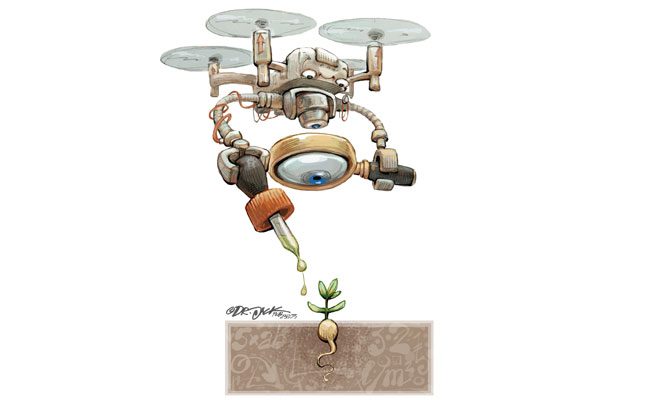
South Africa’s agriculture sector plays a pivotal role, contributing approximately 3% to the country’s GDP and employing an estimated 860 000 people.
The country’s agricultural landscape encompasses an extensive array of commodities, including major grains, oilseeds, deciduous and subtropical fruits, sugar, citrus, wine and vegetables. In addition, the country’s livestock production spans cattle, dairy, hogs, sheep, poultry,and eggs.
Despite its importance, the sector faces challenges that include climate change, water scarcity, and market volatility, which combine to impact its productivity.
To tackle these obstacles and enhance the overall sustainability, profitability and efficiency of the sector, an increasing number of farmers and agribusinesses are embracing precision agriculture technologies.
These cutting-edge tools allow them to monitor, manage and optimise their operations with greater precision and effectiveness.
According to the International Society of Precision Agriculture, precision agriculture involves utilising advanced technologies and principles to address the spatial and temporal variations associated with agricultural production.
Technological innovations
Technological innovations, including the Internet of Things (IoT), drones and data analytics, play a transformative role in shaping the industry’s future.
For example, IoT devices are strategically placed across farms to collect data on crucial parameters such as soil moisture, temperature, nutrient levels, and weather conditions.
This data is then transmitted to cloud platforms or edge devices for thorough analysis, offering farmers invaluable insights for decision-making such as when to plant, water and harvest farmed crops.
Furthermore, IoT devices aid in optimising irrigation schedules, applying fertilisers, managing pests, determining harvest timings, and ensuring animal well-being.
Farmers are increasingly focused on improving the overall productivity of their farmland in order to deliver more value from each acre.
Drones, also called unmanned aerial vehicles (UAVs), equipped with specialised cameras and sensors, are another game-changing tool in modern agriculture.
UAVs capture high-resolution images and videos of crops and livestock from different altitudes and angles, providing farmers with accurate data on crop health, yield estimation, weed detection, and biomass evaluation.
Additionally, drones can be utilised for targeted pesticide or fertiliser application, minimising wastage and optimising resource utilisation.
In 2019, for example, South Africa saw its first legal flight of a drone for spraying crops. Drones have greatly changed farming within the country by being able to spray all parts of a field, even across steep and hard-to-access terrains.
This capability is made possible by sensors and GPS mapping integrated into the drones, enabling them to autonomously adjust their altitude based on the landscape.
This feature eliminates human errors and optimises field coverage, enabling producers to utilise the entire surface area of their fields.
Compared with tractor-based spraying methods, drones are more cost-effective in terms of pricing and overall operation. Drones also eliminate crop loss linked to tractor compaction and use only 10% to 15% of the water required for tractor-based spraying.
In addition, they also aid farming communities dealing with financial burdens of aerial crop spraying. A South African pilot agriculture drone achieved successful chemical application at a rate of 30ℓ/ ha and covering an estimated 6ha area within 1,5 hours.
In light of these developments, adoption of technologies such as drones is an aspect that could contribute to farmers’ increasing productivity, reducing environmental impact and improving farm financial well-being – aspects critical to progressing the industry over the next few years.
Diversification
Diversification is another key strategy being explored from a modern agriculture standpoint. The strategy involves shifting farming dependence on a single or a few commodities to a well-balanced portfolio of activities.
This shift could contribute to the realisation of numerous advantages for both farmers and consumers. Firstly, it contributes to farmers earning more per hectare based on all-year cropping and a diverse portfolio of products.
Secondly, diversification enhances resilience to climate change and other disruptions for the consumer. Thirdly, it promotes improved nutrition and food security through greater dietary diversity and quality.
Thanks to this shift, South African farmers are diversifying through the exploration of high-value crops to grow their revenue streams. Organic farming, specialty foods, and non-food products are a few of the potential avenues that are being considered.
In line with global trends, organic agriculture has gained traction. According to the International Federation of Organic Agriculture (2019), South Africa’s organic agricultural land covers approximately 57 000ha and accounts for only 0,06% of total (global) agricultural land.
There is thus potential to increase this land with potential organic produce consisting of fruit (notably citrus), vegetables (especially potatoes), herbs, spices, tea, coffee, wine, honey, nuts (with a focus on macadamia), dairy products (including cheese), eggs, meat (primarily beef), and wool (sheep).
Conclusion
Precision agriculture offers potential through reshaping farming practices, enabling greater efficiency and improving sustainability and productivity.
Diversification offers the potential to broaden income sources and reduce financial and environmental risks, promotes sustainability and resilience against changing market conditions (fluctuating prices and increasing costs), and allows all-year cropping).










